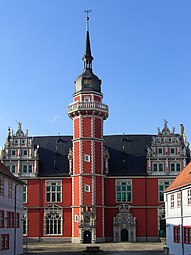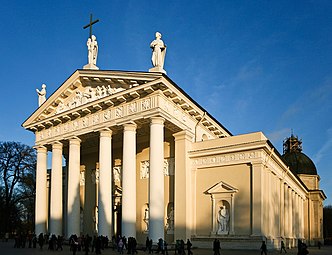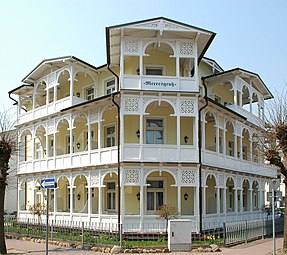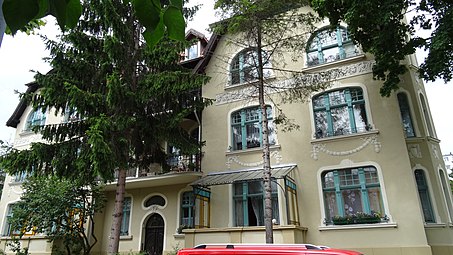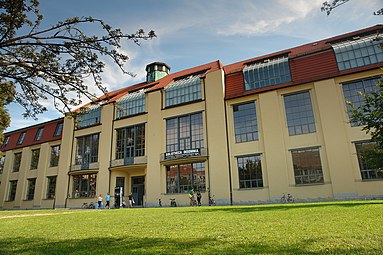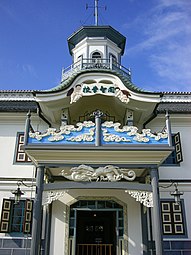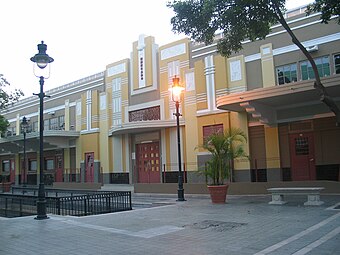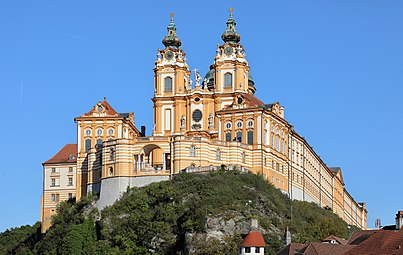Wikipedia list article
An architectural style is characterized by the features that make a building or other structure notable and historically identifiable. A style may include such elements as form , method of construction , building materials , and regional character. Most architecture can be classified as a chronology of styles which change over time reflecting changing fashions, beliefs and religions, or the emergence of new ideas, technology, or materials which make new styles possible.
Styles therefore emerge from the history of a society and are documented in the subject of architectural history . At any time several styles may be fashionable, and when a style changes it usually does so gradually, as architects learn and adapt to new ideas. Styles often spread to other places, so that the style at its source continues to develop in new ways while other countries follow with their own twist. A style may also spread through colonialism , either by foreign colonies learning from their home country, or by settlers moving to a new land. After a style has gone out of fashion, there are often revivals and re-interpretations. For instance, classicism has been revived many times and found new life as neoclassicism . Each time it is revived, it is different.
Vernacular architecture works slightly differently and is listed separately. It is the native method of construction used by local people, usually using labour-intensive methods and local materials, and usually for small structures such as rural cottages. It varies from region to region even within a country, and takes little account of national styles or technology. As western society has developed, vernacular styles have mostly become outmoded by new technology and national building standards.
Examples of styles [ ]
Ancient Roman architecture : Colosseum , an amphitheater in Rome, Italy (1st century AD)
Persian Islamic architecture from the 7th- to 9th-century period: the Shah Mosque , Naqsh-i Jahan Square , Iran
Gothic architecture : St. Vitus Cathedral in Prague , Czech Republic
Weser Renaissance style: Juleum in Helmstedt , Germany
Baroque architecture : Melk Abbey , Austria
Neoclassical architecture : Cathedral of Vilnius in Lithuania
Historicism : Resort architecture in Binz on Rugia Island , a specific style common in German seaside resorts
Secession : Tenement house in Sopot , Poland, built 1904
Early modern architecture : Bauhaus University in Weimar , Germany, built 1911
Postmodern architecture : Wells Fargo Center in Minneapolis , Minnesota, U.S., completed 1988
Beaux-Arts architecture in a bank's building façade in Puerto Rico
Art Deco architecture in a city marketplace building
Chronology of styles [ ] Prehistoric [ ] Early civilizations developed, often independently, in scattered locations around the globe. The architecture was often a mixture of styles in timber cut from local forests and stone hewn from local rocks. Most of the timber has gone, although the earthworks remain. Impressively, massive stone structures have survived for years.
Ancient Americas [ ] Mesoamerican Mezcala Talud-tablero Maya Mediterranean and Middle-East civilizations [ ]
3000–500 BC
Ancient Egyptian 3000 BC–373 BCMinoan 3000?+ BC (Crete)
Mycenaean 1600–1100 BC (Greece)Ancient Near East and Mesopotamia [ ]
Iranian/Persian [ ] Ancient Persian
Iranian , c. 8th century+ (Iran)Persian Garden Style (Iran)
Classical Style – Hayat
Formal Style – Meidān (public) or Charbagh (private)
Casual Style – Park (public) or Bāgh (private)
Paradise garden
Ancient Asian [ ]
Indic [ ] Bengalese Indian Indian rock-cut architecture Karnataka Pakistani Mauryan 321–185 BC (All India)Khmer Indonesian Historic temple styles [ ]
East Asian [ ] Ancient Chinese Japanese Korean Also [ ] Harappan 3300–1600 BCSikh
Classical Antiquity [ ] The architecture of Ancient Greece and Ancient Rome , derived from the ancient Mediterranean civilizations such as at Knossos on Crete. They developed highly refined systems for proportions and style, using mathematics and geometry.
Ancient Greek 776–265 BCRoman 753 BC–663 ADEtruscan 700–200 BCClassical 600 BC–323 ADHerodian 37–4 BC (Judea)Early Christian 100–500Byzantine 527–1520Early Middle Ages [ ] The European Early Middle Ages are generally taken to run from the end of the Roman Empire , around 400 AD, to around 1000 AD. During this period, Christianity made a significant impact on European culture.
Europe [ ] 4th–16th centuries
Anglo-Saxon 450s–1066 (England)Bulgarian from 681
Pre-Romanesque c. 700–1000 (Merovingian and Carolingian empires)
Iberian pre-Romanesque Merovingian 5th–8th centuries (France, Germany, Italy and neighbouring locations)Visigothic 5th–8th centuries (Spain and Portugal)Asturian 711–910 (North Spain, North Portugal)Carolingian 780s–9th century (mostly France, Germany)Ottonian 950s–1050s (mostly Germany, also considered Early Romanesque)[1] Repoblación 880s–11th century (Spain)Medieval Europe [ ] The dominance of the Church over everyday life was expressed in grand spiritual designs which emphasized piety and sobriety. The Romanesque style was simple and austere. The Gothic style heightened the effect with heavenly spires, pointed arches and religious carvings.[2]
Byzantine [ ] Late Byzantine architecture before 1520 (see above)
Romanesque [ ] Timber styles [ ] Stave churches , oldest 845(d ) in England, in Norway one 11th century, several 12th century, some with Romanesque elementsTimber frame styles , mostly Gothic or later (UK, France, Germany, the Netherlands)
Gothic [ ] 1135/40–1520
Gothic 1138–15th century[3]
Angevin Gothic or Plantagenet Style since 1148 (western France)Early English Period c. 1190–c. 1250 since 1266 (southern Italy)
Decorated Period c. 1290–c. 1350Perpendicular Period c. 1350–c. 1550Rayonnant Gothic 1240–c. 1350 (France, Germany, Central Europe)Venetian Gothic 14th–15th centuries (Venice in Italy)Spanish Gothic
Mudéjar Style c. 1200–1700 (Spain, Portugal, Latin America)[4] Aragonese Mudéjar c. 1200–1700 (Aragon in Spain)[4] Isabelline Gothic 1474–1505 (reign) (Spain)Plateresque 1490–1560 (Spain & colonies, bridging Gothic and Renaissance styles)Brick Gothic mid 13th to 16th century (Germany, Netherlands, Flanders, Poland, northern Europe)Brabantine Gothic (Belgium and Netherlands) 14th centuryFlamboyant Gothic 1400–1500 (Spain, France, Portugal)Manueline 1495–1521 (Portugal and colonies)
Asian architecture contemporary with the Dark Ages and medieval Europe [ ]
Japanese [ ] Shinden-zukuri (Heian Period Japan)Chinese [ ] Korean [ ] Dravidian and Vesara temple styles (India) [ ] Badami Chalukya aka "Central Indian temple style" or "Deccan architecture" 450–700Rashtrakuta 750–983 (Central and South India)Western Chalukya aka Gadag 1050–1200 (Karnataka)Hoysala 900–1300 (Karnataka)Vijayanagara 1336–1565 (South India)Other Indian styles [ ] Kalinga Architecture (Orissa and N Andhra Pradesh)
Rekha Deula
Pidha Deula
Khakhara Deula Hemadpanthi 1200–? (Maharashtra)Sikh architecture
Islamic Architecture 620–1918 [ ] Central Styles (Multi-Regional)
Prophetic Era – based in Medina (c. 620–630)
Rashidi Period – based in Medina (c. 630–660)
Umayyad architecture – based in Damascus (c. 660–750)Abbasid architecture – based in Baghdad (c. 750–1256)Mamluk architecture – based in Cairo (c. 1256–1517)Ottoman architecture – based in Istanbul (c. 1517–1918)
Regional Styles
Egypt
Early Islamic architecture (Rashidi + Umayyad) (641–750)Abbasid architecture (750–954)
Fatimid architecture (954–1170)Ayyubid architecture (1174–1250)
Mamluk architecture (1254–1517)
Ottoman architecture (1517–1820)
North Africa (Maghrib)
The Umayyads (705–750)
The Abbasid Era (750–909)
The Fatimids (909–1048)
The Amazigh Dynasties (1048–1550)
Zirids 1048–1148 (Middle Maghreb)
Almoravids 1040–1147 (Far Maghreb)
Almohads 1121–1269 (Far Maghreb)
Hafsids 1229–1574 (Near and Middle Maghreb)
Marinids 1244–1465 (Middle and Far Maghreb)
Zayyanids 1235–1550 (Middle Maghreb)
Ottoman Rule 1550–1830 (Near and Middle Maghreb)
Local Dynasties 1549–present (Far Maghreb)
Islamic Spain
Umayyad architecture (756–1031)
Taifa Kingdoms-1 (1031–1090)
Almoravid architecture (1090–1147)
Taifa Kingdoms-2 (1140–1203)
Almohad architecture (1147–1238),Taifa Kingdoms-3 (1232–1492)
Granada architecture (1287–1492)
Persia and Central Asia
Khurasani architecture (Late 7th–10th century)
Razi Style (10th–13th century)
Samanid Period (10th c.)
Ghaznawid Period (11th c.)
Saljuk Period (11th–12th c.)
Mongol Period (13th c.)
Timurid Style (14th–16th c.)
Isfahani Style (17th–19th c.)
Indian subcontinent
Turkey
American architecture contemporary with the Dark and Middle Ages [ ] Puuc Maya Aztec (ca. 14th century – 1521)The Renaissance and its successors [ ] 1425–1660. The Renaissance began in Italy and spread through Europe, rebelling against the all-powerful Church, by placing Man at the centre of his world instead of God.[5] [6]
Renaissance c. 1425–1600 (Europe, American colonies)
Central European Renaissance
French Renaissance Eastern European Renaissance Palladian 1516–1580 (Venezia, Italy; revived in UK)Mannerism 1520–1600
Polish Mannerism 1550–1650Brâncovenesc style late 17th and early 18th centuriesEastern Orthodox Church 1400?+ (Southeast and Eastern Europe)France [ ] United Kingdom [ ] Tudor 1485–1603Elizabethan 1480–1620?Jacobean 1580–1660Spain and Portugal [ ] Spanish Renaissance Herrerian 1550–1650 (Spain & colonies)Plateresque continued from Spanish Gothic – 1560 (Spain & colonies, Low Countries)Portuguese Renaissance Portuguese Plain style 1580–1640 (Portugal & colonies)Colonial [ ]
Baroque [ ] 1600–1800, up to 1900
Andean Baroque , 1680–1780 (Viceroyalty of Peru )Baroque c. 1600–1750 (Europe, the Americas)English Baroque 1666 (Great Fire) – 1713 (Treaty of Utrecht)Spanish Baroque c. 1600–1760
Churrigueresque , 1660s–1750s (Spain & New World), revival 1915+ (southwest US, Hawaii)Earthquake Baroque , 17th–18th centuries (Philippines )Maltese Baroque c. 1635–1798New Spanish Baroque , mid-17th-early-18th centuries (New Spain )French Baroque c. 1650–1789Dutch Baroque c. 1650–1700Sicilian Baroque 1693 earthquake – c. 1745Portuguese Joanine baroque c. 1700–1750Russian Baroque (c. 1680–1750)
Naryshkin Baroque c. 1690–1720 (Moscow , Russian Empire)Petrine Baroque c. 1700–1745 (Saint Petersburg , Russian Empire)Elizabethan Baroque 1736–1762 (Russian Empire)Ukrainian Baroque late 17th–18th centuries (Ukrainian lands)Rococo c. 1720–1789 (France, Germany, Austria, Italy, Russia, Spain)
Asian architecture contemporary with Renaissance and post-Renaissance Europe [ ] Japanese [ ] Shoin-zukuri (1560s–1860s)Sukiya-zukuri (1530s–present)Minka (Japanese commoner or folk architecture)
Gassho-zukuri (Edo period and later)
Honmune-zukuri (Edo period and later) Imperial Crown Style (1919–1945)Giyōfū architecture (1800s)Indian [ ] Indo-Islamic Mughal 1540–? (India, Pakistan, Bangladesh)
Akbari Mughal Garden Style Sharqi aka Janpur StyleNeoclassicism [ ] 1720–1837 and onward. A time often depicted as a rural idyll by the great painters, but in fact was a hive of early industrial activity, with small kilns and workshops springing up wherever materials could be mined or manufactured. After the Renaissance, neoclassical forms were developed and refined into new styles for public buildings and the gentry.
New Cooperism
Neoclassical [ ] Neoclassical c. 1715–1820Beaux-Arts 1670+ (France) and 1880 (US)Georgian 1720–1840s (UK, US)
American Colonial 1720–1780s (US)Pombaline style 1755 – c. 1860 (Lisbon in Portugal) 1760–1780/90 (Austria)
Adam style 1760–1795 (England, Scotland, Russia, US)Federal 1780–1830 (US)Empire 1804–1830, revival 1870 (Europe, US)Regency 1811–1830 (UK)Antebellum 1812–1861 (Southern United States )Palazzo Style 1814–1930? (Europe, Australia, US)Neo-Palladian
Jeffersonian 1790s–1830s (Virginia in US)American Empire 1810Greek Revival architecture
Rundbogenstil 1835–1900 (Germany)Neo-Grec 1845–65 (UK, US, France)Nordic Classicism 1910–30 (Norway, Sweden, Denmark & Finland)Polish Neoclassicism (Poland)New Classical architecture 20th/21st century (global)Temple 1832+ (global)Revivalism and Orientalism [ ] Late 19th and early 20th centuries. The Victorian Era was a time of giant leaps forward in technology and society, such as iron bridges, aqueducts, sewer systems, roads, canals, trains, and factories. As engineers, inventors, and businessmen they reshaped much of the British Empire, including the UK, India, Australia, South Africa, and Canada, and influenced Europe and the United States. Architecturally, they were revivalists who modified old styles to suit new purposes.
Revivalism Resort architecture (Germany)Victorian 1837–1901 (UK)
See also San Francisco architecture Edwardian 1901–1910 (UK)Revivals started before the Victorian Era [ ] Gothic Revival 1740s+ (UK, US, Europe)
Italianate 1802–1890 (UK, Europe, US)Egyptian Revival 1809–1820s, 1840s, 1920s (Europe, US)Biedermeier 1815–1848 (Central Europe)Russian Revival 1826–1917 (Russian Empire, Germany, Middle Asia)Russo-Byzantine style 1861–1917 (Russian Empire, Balkans)Russian neoclassical revival 1900–1920 (Russian Empire)Victorian revivals [ ] Renaissance Revival 1840–1890 (UK)
Timber frame revivals in various styles (Europe)Black-and-white Revival 1811+ (UK especially Chester)Jacobethan 1830–1870 (UK)Tudorbethan aka Mock Tudor 1835–1885+ (UK)Baroque Revival aka Neo-Baroque 1840?-
Second Empire 1855–1880 (France, UK, US, Canada, Australia)
Napoleon III style 1852–1870 (Paris, France)Queen Anne Style 1870–1910s (UK, US)Romanian Revival 1884-1920s (Romania)Orientalism [ ] Orientalism Neo-Mudéjar 1880s–1920s (Spain, Portugal, Bosnia, California)Moorish Revival (US, Europe)Egyptian Revival 1920s (Europe, US; see above)Mayan Revival 1920–1930s (US)Indo-Saracenic Revival aka Hindu Style, Indo-Gothic, Mughal-Gothic, Neo-Mughal, Hindu-Gothic late 19th century (British India, aka The Raj)
Revivals in North America [ ] Romanesque Revival 1840–1930s (US)Gothic Revival (see above)
Carpenter Gothic 1870+ (US)High Victorian Gothic (English-speaking world)Collegiate Gothic , 1910–1960 (US)Stick Style 1860–1890+ (US)Queen Anne Style architecture (United States) 1880–1910s (US)
Eastlake Style 1879–1905 (US)Richardsonian Romanesque 1880s–1905 (US)Shingle Style 1879–1905Neo-Byzantine 1882–1920s (US)Renaissance Revival
Mission Revival 1894–1936; (California, southwest US)
Pueblo Revival 1898–1930+ (southwest US)Colonial Revival 1890s+Dutch Colonial Revival c. 1900 (New England)Spanish Colonial Revival 1915+ (Mexico, California, Hawaii, Florida, southwest US)Beaux-Arts Revival 1880+ (US, Canada), 1920+ (Australia)City Beautiful 1890–20th century (US)Territorial Revival architecture 1930+Other late 19th century styles [ ]
Rural styles [ ] Swiss chalet style 1840s–1920s+ (Scandinavia, Austria, Germany, later global)Adirondack 1850s (New York, US)National Park Service rustic aka Parkitecture 1903+ (US)Western false front (Western United States )Reactions to the Industrial Revolution [ ] Industrial [ ] Industrial , 1760–present (worldwide)
Arts and Crafts in Europe [ ] Arts and Crafts 1880–1910 (UK)Art Nouveau aka Jugendstil 1885–1910
Modernisme 1888–1911 (Catalan Art Nouveau)Glasgow Style 1890–1910 (Glasgow, Scotland)Vienna Secession 1897–1905 (Austrian Art Nouveau)National Romantic style 1900–1923? (Norway, Sweden, Denmark & Finland)
Arts and Crafts in the US [ ] American Craftsman , aka American Arts and Crafts 1890s–1930 (US)Prairie Style 1900–1917 (US)American Foursquare mid-1890s – late 1930s (US)California Bungalow 1910–1939 (US, Australia, then global)
Modernism and other styles contemporary with modernism [ ] 1880 onwards. The Industrial Revolution had brought steel, plate glass, and mass-produced components. These enabled a brave new world of bold structural frames, with clean lines and plain or shiny surfaces. In the early stages, a popular motto was "decoration is a crime ". In the Eastern Bloc the Communists rejected the Western Bloc 's 'decadent' ways, and modernism developed in a markedly more bureaucratic, sombre, and monumental fashion.
Avant-garde
Chicago School 1880–1920, 1940s–1960s (US)Functionalism c. 1900 – 1930s (Europe, US)Futurism 1909 (Europe)Expressionism 1910 – c. 1924
Amsterdam School 1912–1924 (Netherlands)Organic architecture New Objectivity 1920–1939 (Italy, Germany, Holland, Budapest)Rationalism 1920s–1930s (Italy)Bauhaus 1919–1930+ (Germany, Northern Europe)De Stijl 1920s (Holland, Europe)Moderne 1925+ (global)
Art Deco 1925–1940s (global)
List of Art Deco architecture Streamline Moderne 1930–1937Modernism 1927–1960sInternational Style 1930+ (Europe, US)Usonian 1936–1940s (US)Modernism under communism [ ] Constructivism 1925–1932 (USSR)Postconstructivism 1932–1941 (USSR)Stalinist 1933–1955 (USSR)Fascist/Nazi [ ]
Post-Second World War [ ] 1945–
Modernism (continued)
International Style (continued)
New towns 1946–1968+ (UK, global)Mid-century modern 1950s (California, etc.)Googie 1950s (US)Brutalism 1950s–1970sStructuralism 1950s–1970s
Metabolist 1959 (Japan)Danish Functionalism 1960s (Denmark)Structural Expressionism aka Hi-Tech 1980s+Other 20th century styles [ ] 1900–1940 (Austria, Germany)
Ponce Creole 1895–1920 (Ponce in Puerto Rico)Heliopolis style 1905 – c. 1935 (Egypt)Mar del Plata style 1935–1950 (Mar del Plata in Argentina)Minimal Traditional 1930s–1940s (US)Soft Portuguese 1940–1955 (Portugal & colonies)Ranch-style 1940s–1970s (US)Jengki style (Indonesia)
Postmodernism and early 21st century styles [ ] Postmodernism 1945+ (US, UK)Bowellism Shed Style Arcology 1970s+ (Europe)Deconstructivism 1982+ (Europe, US, Far East)Critical regionalism 1983+Blobitecture 2003+High-tech 1970s+Hostile 2008+ (global)Interactive architecture 2000+Sustainable architecture 2000+
Earthship 1980+ (Started in US, now global)Green building 2000+Natural building 2000+Neo-futurism late 1960s-early 21st centuryNew Classical Architecture 1980+ 1990s+ Fortified styles [ ] Fortification 6800 BC+
Ringfort 800 BC – 400 ADDzong 17th century+Star fort 1530–1800?Polygonal fort 1850?-Vernacular styles [ ]
Generic methods [ ] Natural building Ice – Igloo , quinzhee
Earth – Cob house, sod house , adobe , mudbrick house, rammed earth Timber – Log cabin , log house , Carpenter Gothic , roundhouse , stilt house
Nomadic structures – Yaranga , bender tent
Temporary structures – Quonset hut , Nissen hut , prefabricated home
Underground – Underground living , rock-cut architecture , monolithic church , pit-house
Modern low-energy systems – Straw-bale construction , earthbag construction , rice-hull bagwall construction , earthship , earth house
Various styles – Longhouse
European [ ] European Arctic (North Norway and Sweden, Finland, North Russia) – Sami lavvu , Sami goahti
Northwest Europe (Norway, Sweden, Fresia, Jutland, Denmark, North Poland, UK, Iceland) – Norse architecture , heathen hofs , Viking ring fortress , fogou , souterrain , Grubenhaus (also known as Grubhouse or Grubhut)
Central and Eastern Europe – Burdei , zemlyanka
Bulgaria – Rock-hewn Churches of Ivanovo
Estonia Germany – Black Forest house , Swiss chalet style , Gulf house (aka East Frisian house), Geestharden house (aka Cimbrian house, Schleswig house), Haubarg , Low German house (aka Low Saxon house), Middle German house , Reed house , Seaside resort house , Ständerhaus , Uthland-Frisian house
Holland – Frisian farmhouse , Old Frisian longhouse , Bildts farmhouse
Iceland – Turf houses
Ireland – Clochán , Crannog
Italy – Trullo
Lithuania – Polish-Lithuanian wooden synagogues
Norway – Architecture of Norway : Post church , Palisade church , Stave church , Norwegian Turf house , Vernacular architecture in Norway , Rorbu , Dragestil , also National Romantic style , Swiss chalet style and Nordic Classicism buildings
Poland – Zakopane , Polish-Lithuanian wooden synagogues , wooden churches of Southern Lesser Poland , Upper Lusatian house
Romania – Carpathian vernacular , wooden churches of Maramureș
Scotland – Medieval turf building in Cronberry , blackhouses Slovakia – Wooden churches of the Slovak Carpathians
Spain – Asturian teito , Asturian hórreo , Gallician palloza
Ukraine – Wooden churches
United Kingdom – Dartmoor longhouse , Neolithic long house , palisade church , mid-20th-century system-built houses
European farmhouse types
(If the same type of house is known by alternative names, it may be linked more than once.)
Old European
Housing portal German
Ansitz Black Forest house Cimbrian house East Frisian house Geestharden house Gulf house Haubarg Lorraine house Low German house Middle German house Old Frisian farmhouse Schleswig house Upper Lusatian house Uthland-Frisian house Waldlerhaus Danish Dutch British Scottish Swiss French Spanish Italian Swedish Malta Carpathian
North American [ ] Native American [ ] South American [ ] African [ ] Central and South African countries – Rondavel , , , , , and
Dutch Colonial , Cape Dutch Modern architecture Victorian Architecture Tuscan order Balinese architecture French Architecture Dutch Colonial Revival architecture Contemporary architecture English country house French Colonial Renaissance Neoclassical architecture Romanesque Revival Edwardian Baroque Indian Architecture Hellenistic architecture Georgian Architecture Industrial architecture Asian [ ] China
India – Rock-cut , Toda hut Indonesia – Uma longhouse , attap dwelling
Iran, Turkey – Caravanserai
Iran – Yakhchal
Israel – Rock-cut tombs
Japan – Minka
Mongolia – Yurt
Papua New Guinea –
Philippines – Nipa hut
Russia – Siberian chum
Thailand – Thai stilt house Australasian [ ] Australia, New Zealand – slab hut
Australia – Aborigine humpy
Alphabetical listing [ ]
Adam style 1770 EnglandAdirondack Architecture 1850s New York, USAnglo-Saxon architecture 450s–1066 England and WalesAmerican colonial architecture 1720–1780s USAmerican Craftsman 1890s–1930 US, California & eastAmerican Empire 1810American Foursquare mid. 1890s-late 1930s USAmsterdam School 1912–1924 NetherlandsAncient Egyptian architecture 3000 BC – 373 ADAncient Greek architecture 776 BC – 265 BCAngevin Gothic since 1148, western FranceArcology 1970s AD–presentArt Deco 1925–1940s Europe & USArt Nouveau c. 1885–19101880s–1920s; UK, California, US
Australian architectural styles Baroque architecture Bauhaus 1990s+
Biedermeier 1815–1848Blobitecture 2003–presentBowellism 1957–presentBrick Gothic c. 1350 – c. 15th centuryBristol Byzantine 1850–1880Brownstone Brutalist architecture 1950s–1970sBuddhist architecture 1st century BCByzantine architecture 527 AD (Sofia) – 1520Cape Cod 17th centuryCarolingian architecture 780s–9th century; France and GermanyCarpenter Gothic US and Canada 1840s onChicago school 1880s and 1890 USChilotan architecture 1600–present Chiloé and southern ChileChurrigueresque , 1660s–1750s; Spain and the New WorldCity Beautiful movement 1890–20th century USClassical architecture 600 BC – 323 ADColonial Revival architecture Constructivist architecture Danish Functionalism 1960s AD DenmarkDeconstructivism 1982–presentDecorated Period c. 1290 – c. 1350Dragestil 1880s–1910s, NorwayDutch Colonial 1615–1674 (Treaty of Westminster) New EnglandDutch Colonial Revival c. 1900 New EnglandEarly English Period c. 1190 – c. 1250Eastlake Style 1879–1905 New EnglandEgyptian Revival architecture 1809–1820s, 1840s, 1920sElizabethan architecture (1533–1603)Empire 1804–1814, 1870 revivalEnglish Baroque 1666 (Great Fire) – 1713 (Treaty of Utrecht)Expressionist architecture 1910 – c. 1924Farmhouse Federal architecture 1780–1830 USFederation architecture 1890–1915 AustraliaFlorida cracker architecture c. 1800 – present Florida, USFlorida modern 1950s or Tropical ModernFunctionalism c. 1900 – 1930s Europe & USFuturist architecture 1909 EuropeGeorgian architecture 1720–1840s UK & USGoogie architecture 1950s US and CanadaGothic architecture Gothic Revival architecture 1760s–1840s, since 1266, southern Italy
Greek Revival architecture Green building 2000–presentHeliopolis style 1905 – c. 1935 EgyptIndian architecture IndiaInteractive architecture 2000–presentInternational style 1930–presentIsabelline Gothic 1474–1505 (reign) SpainIslamic Architecture 691–presentItalianate architecture 1802Jacobean architecture 1580–1660Jacobethan 1838Jeffersonian architecture 1790s–1830s Virginia, USJengki style 1950s IndonesiaJugendstil c. 1885–1910 German term for Art Nouveau
Manueline 1495–1521 (reign) Portugal and coloniesMediterranean Revival Style 1890s–present; US, Latin America, EuropeMemphis Group 1981–1988Merovingian architecture 5th–8th centuries; France and GermanyMetabolist Movement 1959 JapanMid-century modern 1950s–1960s California, US, Latin AmericaMission Revival Style architecture 1894–1936; California, USModern movement 1927–1960sModernisme National Park Service Rustic 1872–present USNatural building 2000–Nazi architecture 1933–1944 GermanyNeo-Byzantine architecture 1882–1920s AmericanNeoclassical architecture Neo-Grec 1848–1865Neo-gothic architecture Neolithic architecture 10,000–3000 BCNeo-Manueline 1840s–1910s AD Portugal and BrazilNew towns 1946–1968 United KingdomNorman architecture 1074–1250Organic Architecture Ottonian architecture 950s–1050s GermanyPalladian architecture 1616–1680 (Jones)Perpendicular Period c. 1350 – c. 1550Plantagenet Style since 1148, western FranceSouthern plantation architecture Ponce Creole 1895–1920 Ponce, Puerto Rico Pombaline style 1755 earthquake – c. 1860 PortugalPostmodern architecture 1980sPolish Cathedral Style 1870–1930Polite architecture Prairie Style 1900–1917 USPueblo style 1898–1990sShingle Style 1879–1905 New EnglandQueen Anne Style architecture 1870–1910s UK and USQueenslander 1840s–1960sRanch-style 1940s–1970s USRepoblación architecture 880s–11th century; SpainRegency architecture Richardsonian Romanesque 1880s USRococo Roman architecture 753 BC – 663 ADRomanesque architecture 1050–1100Romanesque Revival architecture 1840–1900 USRussian architecture 989 – 18th centuryRussian Revival 1826–1917, 1990s–presentSaltbox San Francisco architecture Scottish Baronial Second Empire 1865–1880Serbo-Byzantine revival Interwar periodSicilian Baroque 1693 earthquake – c. 1745Soft Portuguese style 1940–1955 Portugal & coloniesSpanish Colonial Revival style 1915–present; California, Hawaii, Florida, Southwest USSpanish Colonial style 1520s – c. 1820s; New World, East Indies, other coloniesc. 1900–present; California, Florida, US, Latin America, Spain.
Stalinist architecture 1933–1955 USSRStave churches , oldest 845(d) in England, Norway one 11th century, several 12th centuryStick Style 1860–1890sStorybook 1920sStreamline Moderne 1930–1937Structural Expressionism 1980s–presentStructuralism 1950–1975Sumerian architecture 5300 – 2000 BCSustainable architecture 2000–presentSwiss chalet style 1840s–1920s, Scandinavia and GermanyTidewater architecture 19th centuryTudor architecture 1485–1603Tudorbethan architecture 1835–1885Ukrainian Baroque late 1600 – 19th centuryUsonian 1936–1940s USVictorian architecture 1837–1901 UKVienna Secession 1897 – c. 1905 Austrian Art Nouveau
See also [ ] References [ ]
^ Hans Erich Kubach. Architektur der Romanik , 1973/1974, 3-7630-1705-7, p. 63–144 Die erste Romanische Kunst – Frühromanische Architektur
^ Robert Stuart (1854), Cyclopedia of architecture: historical, descriptive, typographical, decorative, theoretical and mechanical, alphabetically arranged, familiarly explained, and adapted to the comprehension of workmen , A. S. Barnes & Co, p. 75 ^ a b Gebaut, Burgundische Romanik – Pontigny – Zisterziensergotik ^ a b Really, Mudéjar style had phases according to the general European styles, there was Romanesque Mudéjar, Gothic Mudéjar and even Renaissance Mudéjar.
^ Gerald Leinwand, The pageant of world history , Prentice-Hall, 1990, page 330
^ Jackson J. Spielvogel (2010), Western Civilization: A Brief History . Cengage Learning. page 333 ISBN 0495571474
White, Norval; Elliott Willensky (2000). AIA Guide to New YorkISBN 0-8129-3107-6 Lewis, Philippa; Gillian Darley (1986). Dictionary of Ornament , NY: Pantheon
Baker, John Milnes, AIA (1994) American House Styles , NY: Norton Further reading [ ] Hamlin Alfred Dwight Foster, History of Architectural Styles , BiblioBazaar, 2009
Carson Dunlop, Architectural Styles , Dearborn Real Estate, 2003
Herbert Pothorn, A guide to architectural styles , Phaidon, 1983 External links [ ] 


